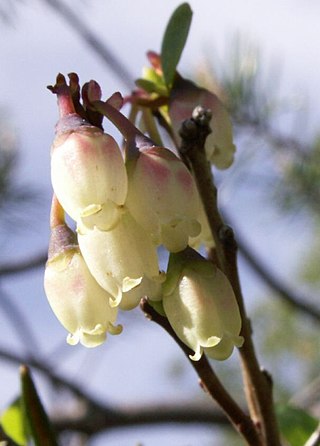| Disterigma | |
|---|---|
 | |
| Disterigma empetrifolium | |
| Scientific classification | |
| Kingdom: | Plantae |
| Clade: | Tracheophytes |
| Clade: | Angiosperms |
| Clade: | Eudicots |
| Clade: | Asterids |
| Order: | Ericales |
| Family: | Ericaceae |
| Genus: | Disterigma (Klotzsch) Nied. |
Disterigma is a genus of flowering plants belonging to the family Ericaceae, [1] sometimes referred to as the neotropical blueberries, [2] native to Mexico and Central America as well as Bolivia, Colombia, Ecuador and Perú. [1] These shrubs have adapted to thrive within montane cloud forests and páramos (high-altitude wet 'tundra' habitats), usually above 2,000 m (6,561') above sea level. [2]
Species: [1]
- Disterigma acuminatum (Kunth) Nied.
- Disterigma agathosmoides (Wedd.) Nied.
- Disterigma alaternoides (Kunth) Nied.
- Disterigma appendiculatum Pedraza
- Disterigma baguense Pedraza
- Disterigma balslevii Luteyn
- Disterigma bracteatum Luteyn
- Disterigma campanulatum Pedraza
- Disterigma campii A.C.Sm.
- Disterigma chocoanum Pedraza
- Disterigma codonanthum S.F.Blake
- Disterigma cryptocalyx A.C.Sm.
- Disterigma dumontii Luteyn
- Disterigma ecuadorense Luteyn
- Disterigma empetrifolium (Kunth) Nied.
- Disterigma fortunense Wilbur
- Disterigma hammelii Wilbur & Luteyn
- Disterigma hiatum Pedraza
- Disterigma humboldtii (Klotzsch) Nied.
- Disterigma leucanthum A.C.Sm.
- Disterigma luteynii Wilbur
- Disterigma micranthum A.C.Sm.
- Disterigma noyesiae Luteyn
- Disterigma ollacheum Pedraza
- Disterigma ovatum (Rusby) S.F.Blake
- Disterigma panamense Standl.
- Disterigma parallelinerve Pedraza
- Disterigma pentandrum S.F.Blake
- Disterigma pernettyoides (Griseb. ex Wedd.) Nied.
- Disterigma pilosum Wilbur
- Disterigma pseudokillipiella Luteyn
- Disterigma rimbachii (A.C.Sm.) Luteyn
- Disterigma staphelioides (Planch. ex Wedd.) Nied.
- Disterigma stereophyllum (A.C.Sm.) Luteyn
- Disterigma synanthum Pedraza
- Disterigma trimerum Wilbur & Luteyn
- Disterigma ulei Sleumer
- Disterigma utleyorum Wilbur & Luteyn
- Disterigma verruculatum Pedraza
- Disterigma weberbaueri Hoerold










